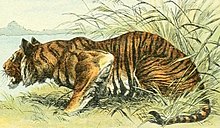
The coyote, also known as the American jackal, prairie wolf, or brush wolf is a species of canine native to North America. It is smaller than its close relative, the gray wolf, and slightly smaller than the closely related eastern wolf and red wolf. It fills much of the same ecological niche as the golden jackal does in Eurasia, however, the Coyote is generally larger.

The cougar, also known as the panther, mountain lion, catamount and puma, is a large cat native to the Americas. It inhabits North, Central and South America, making it the most widely distributed wild, terrestrial mammal in the Western Hemisphere, and one of the most widespread in the world. Its range spans the Canadian Territory of Yukon, British Columbia and Alberta provinces, the Rocky Mountains and areas in the Western United States. Further south, its range extends through Mexico to the Amazon Rainforest and the southern Andes Mountains in Patagonia. It is an adaptable, generalist species, occurring in most American habitat types. It prefers habitats with dense underbrush and rocky areas for stalking but also lives in open areas.

The leopard seal, also referred to as the sea leopard, is the second largest species of seal in the Antarctic. Its only natural predator is the orca. It feeds on a wide range of prey including cephalopods, other pinnipeds, krill, fish, and birds, particularly penguins. It is the only species in the genus Hydrurga. Its closest relatives are the Ross seal, the crabeater seal and the Weddell seal, which together are known as the tribe of Lobodontini seals. The name hydrurga means "water worker" and leptonyx is the Greek for "thin-clawed".
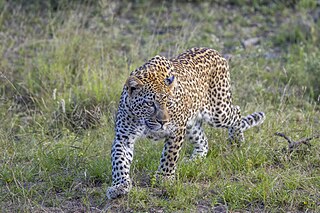
The African leopard is the nominate subspecies of the leopard, native to many countries in Africa. It is widely distributed in most of sub-Saharan Africa, but the historical range has been fragmented in the course of habitat conversion. Leopards have also been recorded in North Africa as well.
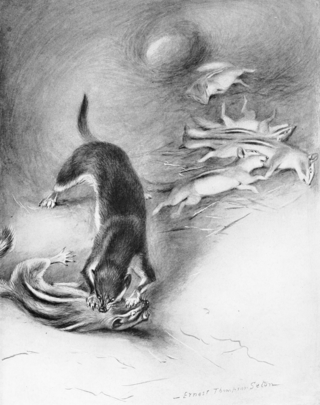
Surplus killing, also known as excessive killing, henhouse syndrome, or overkill, is a common behavior exhibited by predators, in which they kill more prey than they can immediately eat and then they either cache or abandon the remainder. The term was invented by Dutch biologist Hans Kruuk after studying spotted hyenas in Africa and red foxes in England. Some of the other animals which have been observed engaging in surplus killing include orcas, zooplankton, humans, damselfly naiads, predaceous mites, martens, weasels, honey badgers, jaguar, leopards, lions, wolves, spiders, brown bears, American black bears, polar bears, coyotes, lynxes, minks, raccoons and dogs.

The Indian leopard is a subspecies of the leopard that was first scientifically described in 1794. It is widely distributed on the Indian subcontinent. It is threatened by illegal trade of skins and body parts, and persecution due to human-leopard conflict and retaliation for livestock depredation.

Savile's bandicoot rat is a species of rodent in the family Muridae found in Myanmar, Thailand, and Vietnam. This species inhabits dry agricultural lands, where they feed on crops such as corn.
Disease is described as a decrease in performance of normal functions of an individual caused by many factors, which is not limited to infectious agents. Furthermore, wildlife disease is a disease when one of the hosts includes a wildlife species. In many cases, wildlife hosts can act as a reservoir of diseases that spillover into domestic animals, people and other species. Wildlife diseases spread through both direct contact between two individual animals or indirectly through the environment. Additionally, human industry has created the possibility for cross-species transmission through the wildlife trade.Furthermore, there are many relationships that must be considered when discussing wildlife disease, which are represented through the Epidemiological Triad Model. This model describes the relationship between a pathogen, host and the environment. There are many routes to infection of a susceptible host by a pathogen, but when the host becomes infected that host now has the potential to infect other hosts. Whereas, environmental factors affect pathogen persistence and spread through host movement and interactions with other species. An example to apply to the ecological triad is Lyme disease, where changes in environment have changed the distribution of Lyme disease and its vector, the Ixodes tick. The recent increase in wildlife disease occurrences is cause for concern among conservationists, as many vulnerable species do not have the population to recover from devastating disease outbreaks.
A man-eater is an individual animal or being that preys on humans as a pattern of hunting behavior. This does not include the scavenging of corpses, a single attack born of opportunity or desperate hunger, or the incidental eating of a human that the animal has killed in self-defense. However, all three cases may habituate an animal to eating human flesh or to attacking humans, and may foster the development of man-eating behavior.

Human–wildlife conflict (HWC) refers to the negative interactions between humans and wild animals, with undesirable consequences both for people and their resources on the one hand, and wildlife and their habitats on the other. HWC, caused by competition for natural resources between human and wildlife, influences human food security and the well-being of both humans and other animals. In many regions, the number of these conflicts has increased in recent decades as a result of human population growth and the transformation of land use.
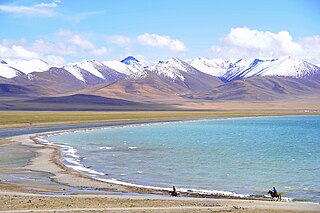
The Trans himalaya, or "Gangdise – Nyenchen Tanglha range", is a 1,600-kilometre-long (990 mi) mountain range in China, India and Nepal, extending in a west–east direction parallel to the main Himalayan range. Located north of Yarlung Tsangpo river on the southern edge of the Tibetan Plateau, the Transhimalaya is composed of the Gangdise range to the west and the Nyenchen Tanglha range to the east.

A mesocarnivore is an animal whose diet consists of 50–70% meat with the balance consisting of non-vertebrate foods which may include insects, fungi, fruits, other plant material and any food that is available to them. Mesocarnivores are from a large family group of mammalian carnivores and vary from small to medium sized, which are less than fifteen kilograms. Mesocarnivores are seen today among the Canidae, Viverridae (civets), Mustelidae, Procyonidae, Mephitidae (skunks), and Herpestidae. The red fox is also the most common of the mesocarnivores in Europe and has a high population density in the areas they reside.
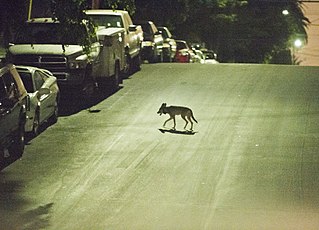
Urban coyotes are coyotes that reside in North American metropolitan areas. Coyotes thrive in suburban settings and urban regions because of the availability of food and the lack of predators. One report described them as "thriving" in U.S. cities, and a 2013 report in The Economist suggested that urban coyotes were increasingly living in cities and suburbs.

Leopard attacks are attacks inflicted upon humans, other leopards and other animals by the leopard. The frequency of leopard attacks on humans varies by geographical region and historical period. Despite the leopard's extensive range from sub-Saharan Africa to Southeast Asia, attacks are regularly reported only in India and Nepal. Among the five "big cats", leopards are less likely to become man-eaters—only jaguars and snow leopards have a less fearsome reputation. However, leopards are established predators of non-human primates, sometimes preying on species as large as the western lowland gorilla. Other primates may make up 80% of the leopard's diet. While leopards generally avoid humans, they tolerate proximity to humans better than lions and tigers, and often come into conflict with humans when raiding livestock.

The predation problem or predation argument refers to the consideration of the harms experienced by animals due to predation as a moral problem, that humans may or may not have an obligation to work towards preventing. Discourse on this topic has, by and large, been held within the disciplines of animal and environmental ethics. The issue has particularly been discussed in relation to animal rights and wild animal suffering. Some critics have considered an obligation to prevent predation as untenable or absurd and have used the position as a reductio ad absurdum to reject the concept of animal rights altogether. Others have criticized any obligation implied by the animal rights position as environmentally harmful.

Folsomia fimetaria is an elongate-bodied springtail of the genus Folsomia. It differs from other members of the Folsomia genus, in that the ventral setae on the third segment of the thorax are absent. It its maxillary head their lamella 1 is fan-shaped and has a double fringe, also its apical row has complex cilia. F. fimetaria inhabits in rich organic soils, disturbed biotopes and cities. It also seems to be a high-quality prey, since, when eaten by Bembidion lampros they seem to improve their fecundity and their larval survival.

Spotted hyenas are widely distributed in Ethiopia specifically in the eastern parts like Harar and Somali Region. They also dwell in urban areas like Addis Ababa where they have been estimated at about a thousand and scavenge rubbish substances and feral dogs and cats. Scavenging on remains is a common feature of spotted hyenas that focus around waste material and also corpses.

In ecology, hunting success is the proportion of hunts initiated by a predatory organism that end in success. Hunting success is determined by a number of factors such as the features of the predator, timing, different age classes, conditions for hunting, experience, and physical capabilities. Predators selectivity target certain categories of prey, in particular prey of a certain size. Prey animals that are in poor health are targeted and this contributes to the predator's hunting success. Different predation strategies can also contribute to hunting success, for example, hunting in groups gives predators an advantage over a solitary predator, and pack hunters like lions can kill animals that are too powerful for a solitary predator to overcome.

Eivin Røskaft is a Norwegian evolutionary biologist, academic, and author. He is a professor emeritus in evolutionary biology at the department of biology at the Norwegian University of Science and Technology (NTNU) in Trondheim, Norway. Røskaft's research is focused on the application of evolutionary biology to conservation, which has led to projects in Asia and Africa that pertain to human-wildlife conflict, animal population dynamics, and animal behaviour in relation to human activities. He has authored or co-authored several publications, including the books Conservation of Natural Resources: Some African & Asian Examples, and Northern Serengeti Road Ecology, and is an honorary professor at Hainan University, Haikou, China, and Palacký University Olomouc, Czech Republic. He is also an elected member of Royal Norwegian Scientific Society, and the recipient of their Scientific Award.
